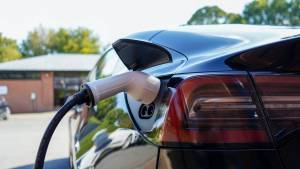
Electric Vehicle Charging: A New Partnership for North America
The consortium’s ambitious plan is to install a minimum of 30,000 fast EV chargers by the year 2030. The first network of charging stations is scheduled to be operational in the United States by the summer of 2024. Funding for this project comes from various sources, including the federal government’s National Electric Vehicle Infrastructure (NEVI) program, as well as private and public funds.
The primary goal of this partnership is to enhance the overall EV charging experience. At present, there are numerous unreliable charging networks that require separate apps for each network. By enabling EVs from the collaborating automakers to connect and charge using a single app, the new charging stations aim to eliminate these complexities. This streamlined approach seeks to simplify the charging process, making it more convenient for EV owners and encouraging the adoption of EVs.
Strategic placement of the new charging stations is another crucial aspect of the joint venture. Similar to existing charging networks like Tesla Superchargers and Electrify America, the stations will be strategically located in places where people frequently spend time. This includes major thoroughfares, urban areas, and popular tourist spots. The aim is to ensure that EV owners can always find a charging station nearby, regardless of their location or activity.
To promote compatibility and ease of use for EV owners, the charging stations will support a wide variety of EV models. Each station will include both Tesla North American Charging Standard (NACS) ports and Combined Charging System (CCS) plugs, eliminating the need for special adapters or compatibility concerns.
Moreover, the joint venture is committed to adopting the emerging “Plug and Charge” standard, advocated by the Federal Highway Administration. This standardization aims to create a uniform method for charging EVs, streamlining the charging process and encouraging compatibility among different EV models.
In line with the broader objective of environmental sustainability, the partnership has pledged to power the charging stations with renewable energy. Though specific details on how this will be achieved are yet to be revealed, potential approaches include direct renewable energy supply and the purchase of renewable energy credits. This commitment reflects the consortium’s dedication to improving the environmental sustainability of the transportation system.
While the initial focus is on the United States, the joint venture has plans to expand into Canada as well. The ultimate aim is to cover the entire North American region, demonstrating the automakers’ dedication to providing comprehensive charging solutions for EV owners across the continent.
The completion of the full network by 2030 will mark a significant advancement in the evolution of the EV charging infrastructure in North America. The joint venture’s use of NEVI funding and other resources demonstrates its commitment to building a charging infrastructure that can accommodate the growing number of EVs on the road. With its support for the Plug and Charge standard, dedication to renewable energy, and compatibility with a wide range of EV models, the network represents a forward-thinking response to the evolving needs of EV owners. It is a pioneering step towards eco-friendly transportation and bodes well for the future of electric vehicle charging in North America, the expansion of the EV market, and environmental sustainability.

